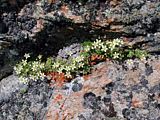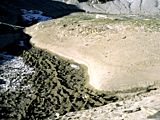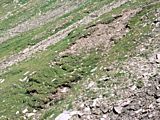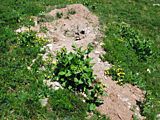Mineral nutrition

1 -
Saxifraga bryoides
on bare rock
1 -
Saxifraga bryoides
on bare rock
- On site weathering of minerals.

2 -
Glacier forefield (Wildstrubel glacier, Swiss Alps)
2 -
Glacier forefield (Wildstrubel glacier, Swiss Alps)

3 -
Left: fresh silt deposited from a glacier creek; right: border of an
alpine sand dune (near the Pasterze glacier, Grossglockner, Austrian Alps).
3 -
Left: fresh silt deposited from a glacier creek; right: border of an
alpine sand dune (near the Pasterze glacier, Grossglockner, Austrian Alps).
-
Release from mineral dust imported by wind
(aeolic
deposition) or run-off water (silt deposition) which together may accumulate
up to 1 mm per year of dust and fine silt, commonly derived from open
terrain such as glacier forefields
(Fig. 2)
and moraines. There are even
sand dunes in some alpine areas
(Fig. 3).
Alpine plants are commonly not short in mineral nutrients, because of the young age
of soils and slope activity
(Fig. 4).
In old
humic
soils
(Fig. 5)
on relatively flat ground in humid climates, leaching
(podzolisation,
see slope processes and alpine soils) can, however, lead to the loss of essential
nutrients. Disturbance of these sites (e.g. by digging a supply line or by ground
animal activity,
Fig. 6)
can create long-lasting visible changes in plant cover (more
lush appearance).

4 -
Fresh mineral nutrients released by natural disturbance.
4 -
Fresh mineral nutrients released by natural disturbance.

5 -
Old soils on flat ground may have lost nutrients through leaching.
5 -
Old soils on flat ground may have lost nutrients through leaching.

6 -
Re-vitalisation by disturbance by ground animals (a marmot hole).
6 -
Re-vitalisation by disturbance by ground animals (a marmot hole).






